
IELTS vs. TOEFL: Which English Proficiency Test is Right for You?
If you're planning to study, work, or migrate to an English-speaking country, proving your English proficiency is often a key requirement. The two most widely recognised tests for this purpose are IELTS (International English Language Testing System) and TOEFL (Test of English as a Foreign Language). Both assess your reading, writing, listening, and speaking skills, but they differ in format, scoring, and suitability for different goals. Understanding these differences can help you choose the test that best aligns with your needs.
1. Understanding IELTS and TOEFL
What is IELTS?
IELTS is jointly administered by the British Council, IDP: IELTS Australia, and Cambridge Assessment English. It is accepted by over 11,000 institutions worldwide, including universities, employers, and immigration authorities. IELTS has two main versions:
- Academic IELTS – Designed for students seeking admission to universities or professional registration.
- General Training IELTS – Required for migration purposes or secondary education.
What is TOEFL?
TOEFL, managed by ETS (Educational Testing Service), is widely accepted, especially by institutions in the United States. It primarily caters to students applying for higher education and is available in two formats:
- TOEFL iBT (Internet-Based Test) – The most commonly used version, conducted online.
- TOEFL Paper-Based Test (PBT) – Offered in locations without internet access.
2. Test Format and Structure
IELTS Format
IELTS consists of four sections:
- Listening (30 minutes) – Includes conversations and monologues with a variety of accents.
- Reading (60 minutes) – Comprehension questions based on academic or general texts.
- Writing (60 minutes) – Two writing tasks assessing analytical and descriptive abilities.
- Speaking (11-14 minutes) – A face-to-face interview with an examiner.
One of IELTS's unique features is the in-person speaking test, making it a better option for candidates who prefer real-time conversations.
IELTS Scoring System
IELTS is graded on a band scale from 0 to 9, with each score indicating a different level of English proficiency. Most universities require a minimum overall score of 6.0 or 6.5, with individual section requirements.
TOEFL Format
TOEFL also has four sections:
- Reading (60-80 minutes) – Multiple-choice questions based on academic passages.
- Listening (60-90 minutes) – Recorded lectures and conversations with note-taking allowed.
- Speaking (20 minutes) – Responses recorded and evaluated by examiners.
- Writing (50 minutes) – Two writing tasks assessing essay and summary-writing skills.
Unlike IELTS, the TOEFL speaking section requires candidates to speak into a microphone, which may feel less interactive for some.
TOEFL Scoring System
TOEFL scores are out of 120 points, with each section scored from 0 to 30. Universities generally require a minimum score between 80 and 100, with top institutions asking for 100 or above.
3. Key Differences Between IELTS and TOEFL
Test Format & Speaking Section
- IELTS: Speaking test is conducted face-to-face with an examiner.
- TOEFL: Speaking responses are recorded and graded later.
Question Types
- IELTS: Includes multiple-choice, short-answer, and gap-fill questions.
- TOEFL: Primarily uses multiple-choice questions.
English Accents
- IELTS: Exposes test-takers to British, Australian, and other accents.
- TOEFL: Uses predominantly American English.
Scoring System
- IELTS: Band scale from 0 to 9 for each section.
- TOEFL: Scored out of 120, with each section marked from 0 to 30.
4. Which Test Should You Choose?
For University Admissions
- US & Canadian Universities: TOEFL is preferred.
- UK, Australia, & Europe: IELTS is widely accepted.
For Immigration
- IELTS is usually required for immigration to the UK, Canada, and Australia.
For Test-Taking Experience
- If you prefer face-to-face speaking, go for IELTS.
- If you are comfortable speaking into a microphone, TOEFL may be better.
5. Tips for Success
- Understand the Format: Familiarise yourself with the test structure before taking it.
- Practice Regularly: Improve your reading, writing, listening, and speaking skills.
- Take Mock Tests: Simulate real test conditions to boost confidence.
- Seek Guidance: Consider coaching classes or study resources if needed.
Conclusion
Choosing between IELTS and TOEFL depends on your academic and professional goals, personal preferences, and the requirements of your desired institution or immigration program. Both tests are widely recognised and offer a fair assessment of English proficiency. The best approach is to select the test that aligns with your strengths and preparation style. Whichever you choose, dedicated practice and thorough preparation will lead to success. Good luck!